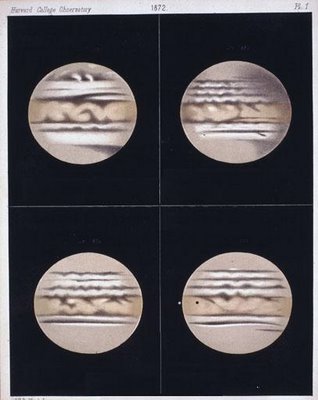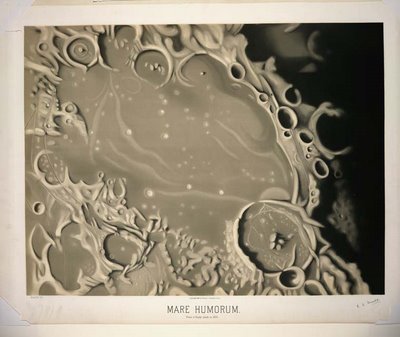"[T]hese views were produced using the [Harvard] observatory's 15-inch refracting telescope made by Merz of Munich, Germany. They show the planet's characteristic cloud belts with festoon structures within that have been now been resolved in detail by robot spacecrafts such as Voyager. At this time, drawings made at the telescope using only the eyes showed more detail than could be produced using the insensitive photographic plates then available."
Frenchman Étienne Léopold Trouvelot (1827–1895) was primarily a portrait artist when he arrived in Massachusetts in 1852. During the following 30 years that he remained in America his amateur passion for science would ensure a legacy that straddles both fame and infamy.
Trouvelot had a particular love for silkworms and he had a 4 acre plot behind his house where he cultivated a native variety. To increase production he hoped to crossbreed the regular type with a species from Europe. He brought back Gypsy Moth eggs from a trip home and so introduced a virulent pest that ravages forests in America to this day. To his (slight) credit, he realized the enormity of the problem straight away when some of the introduced moths escaped. He made it publically known, but unfortunately local entomologists did nothing at the time to eradicate them.
Trouvelot turned his attention from moths to the stars and began illustrating celestial phenomena. His drawings were so good that the Director of Harvard College Observatory put Trouvelot on staff where he gained access to their powerful telescope.
He would go on to produce some 7000 astronomical drawings and publish 50 scientific papers. His works were displayed at the Philadelphia Centennial Exposition in 1876 and Trouvelot began to assemble his best drawings for wider publication. In 1881 a series of 15 chromolithographs were released for $125 (!) to great acclaim. He spent the last 3 years of his life back in France pursuing his fascination for solar phenomena.
- The 15 lithographs from 'Astronomical Drawings' are online at NYPL.
- NYPL also have a great site - 'Art & Actuality: Heavens Above' - with a large section on Trouvelot, his drawings, contemporary astrophotography and modern astronomical images.
- The '4 Jupiters' image above (sans watermark) comes from Science and Society - they have a few additional illustrations by Trouvelot.


























8 comments :
There is something about some of these works that have me thinking of Kandinsky. I wish I had extra dough to blow, prints of these are available for only $30.
Thanks for continuing to expose me to great images.
Actually someone at Monkeyfilter tells us that the Jupiter image shows the double shadow transit of the moons Io and Europa.
Cool indeed!
Those are awesome pictures!
Breathtaking! There is something so surreal about these drawings.
Strikingly beautiful images. I can't believe I've never heard of this guy before. Thanks for dragging him out of obscurity.
Many more Trouvelot sketches can be found towards the bottom of this Harvard Annals page.
[Thanks to Eric from the Cloudy Nights astronomical community].
You might want to check out the plates at the end of Annals of the Astronomical Observatory of Harvard College, Volume VIII.
Thanks Bill!
Post a Comment
Comments are all moderated so don't waste your time spamming: they will never show up.
If you include ANY links that aren't pertinent to the blog post or discussion they will be deleted and a rash will break out in your underwear.
Also: please play the ball and not the person.
Note: only a member of this blog may post a comment.